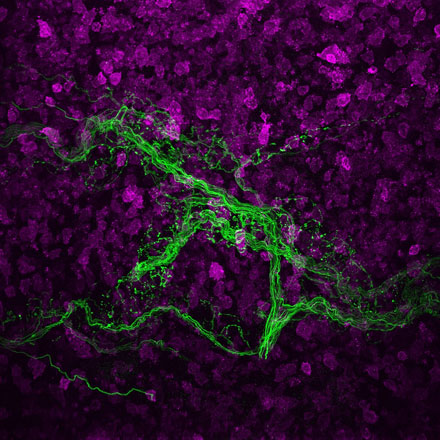|
Wednesday, August 3, 2022 |
|

|

|
Large-scale interdisciplinary research efforts have worked to comprehensively catalog cellular architectures in health and disease. To aid in this effort, researchers have developed a scalable imaging platform that delivers isotropic subcellular resolution throughout millimeters of chemically cleared tissues. The system, referred to as cleared-tissue axially swept light-sheet microscopy (CT-ASLM), leverages high-speed, aberration-free remote focusing to achieve an isotropic resolution of 300-nm with unparalleled optical sectioning capacity throughout a large field of view. Due to CT-ASLM’s performance, researchers can now routinely resolve and automatically segment dendritic spines, evaluate cell-type differences in mitochondrial composition, and quantitatively measure hematopoietic stem cell interactions in a bone marrow plug. Thus, CT-ASLM provides not only global tissue architectures but also quantitatively detailed morphological and biochemical descriptions of the individual cells that compose tissues in health and disease.
Who should attend:
Scientists, researchers, laboratory technicians, clinicians, and others in the fields of biology, biotechnology, microbiology, and other areas of the life sciences who are using light-sheet microscopy. Engineers and commercial representatives involved in R&D and marketing of the CT-ASLM system. Those working in industries such as cancer research, histopathology, biophotonics, and medicine.
About the presenter:
Kevin Dean, Ph.D., runs an interdisciplinary lab at the University of Texas (UT) Southwestern Medical Center, which aims to identify the molecular mechanisms that enable cancer cells to populate a distant tissue. To achieve this, his lab develops and applies cutting-edge microscopy instrumentation, optical probes, tissue clearing, and computer vision analyses. Further, he helps lead a National Cancer Institute Cellular Cancer Biology Imaging Research Center that aims to advance knowledge of early metastatic colonization events. Dean received his Bachelor of Arts in chemistry at Willamette University in Oregon and his doctorate in biochemistry at the University of Colorado. His graduate work, which took place under the guidance of Amy Palmer and Ralph Jimenez, focused on spectroscopy, protein engineering, and multiparameter high-throughput microfluidic analyses and cell sorting. Following graduation, he established the first campus-wide light microscopy facility at the BioFrontiers Institute at the University of Colorado and then moved to the UT Southwestern Medical Center in Dallas to perform his postdoctoral research under the guidance of Gaudenz Danuser and Reto Fiolka. During this time, he was named a Ruth L. Kirschstein Postdoctoral Fellow, received the Dean’s Discretionary Award at UT Southwestern, and was the runner-up for the UT Southwestern Brown-Goldstein Award for Excellence in Postdoctoral Research.
About the sponsors:
Power Technology, Inc. has been a driving force in the laser industry for over fifty years. They design, develop, and manufacture a comprehensive range of laser products for scientific, biomedical, industrial, semiconductor inspection, machine vision, defense and security applications. Their modules are ideal for any number of OEM and research-based applications, including microscopy, display, spectroscopy, holography, laser-induced fluorescence, flow cytometry, and high-resolution printing.
Intelligent Imaging Innovations Inc. (3i) designs and manufactures technologies for living cell, live cell, and intravital fluorescence microscopy including super resolution, computer-generated holography, spinning disk confocal, multi-photon and lightsheet. SlideBook software manages everything from instrument control to image capture, processing, and data analysis. Established in 1995, 3i is headquartered in Denver, Colorado (USA) with offices in London, United Kingdom, Paris, France, and Göttingen, Germany.
Applied Scientific Instrumentation, Inc. (ASI) is a company committed to the advancement of science. Their core business is moving objects and light in optical microscopes, and they have a wide variety of associated products including motorized and piezo stages, filter wheels, hardware autofocus, components to make modular microscopes, light sheet microscopes, and specialty objective lenses.
|
|
|
|
Date: Wednesday, August 17, 2022
Time: 1:00 PM - 2:00 PM EDT
Space is limited. Reserve your Webinar seat now at: https://attendee.gotowebinar.com/register/8336550362424431372?source=Eblast
After registering you will receive a confirmation email containing information about joining the Webinar.
|
|
|
SYSTEM REQUIREMENTS
Operating System
Windows® 7 or later, Mac OS® X 10.9 or later, Linux®, Google ChromeTM OS
AndroidTM OS 5 or later, iOS® 10 or later
Web Browser
Google ChromeTM (most recent 2 versions)
Mozilla Firefox® (most recent 2 versions)
Mobile Devices
AndroidTM 5 or later
iPhone® 4S or later
iPad® 2 or later
Windows Phone® 8+, Windows® 8RT+
|
|
|
|
.: More from Photonics Media
|
|
|
|